ENG3104: Engineering Simulations and Computations Assignment 2
VerifiedAdded on 2022/11/09
|28
|5030
|219
Homework Assignment
AI Summary
This assignment solution for ENG3104 focuses on simulating the landing of the Apollo 11 Lunar Module (LM). The solution begins by calculating the force required for a given linear acceleration using Newton's second law, considering the mass of the LM. It then analyzes the forces and moments involved when thrusters are not aligned with the center of gravity, using simultaneous equations and matrix methods to determine individual thruster forces. The solution incorporates MATLAB code to verify the calculations, including scenarios with angular acceleration and forces in multiple directions. The document then explores the impact of thrusters in the y and z directions, and how the location of thrusters affects the force distribution. The document presents the calculations for different cluster configurations, and how the forces change based on the distance from the center of gravity. The solution includes detailed MATLAB code and output for each scenario, providing a comprehensive understanding of the LM's control system during descent.
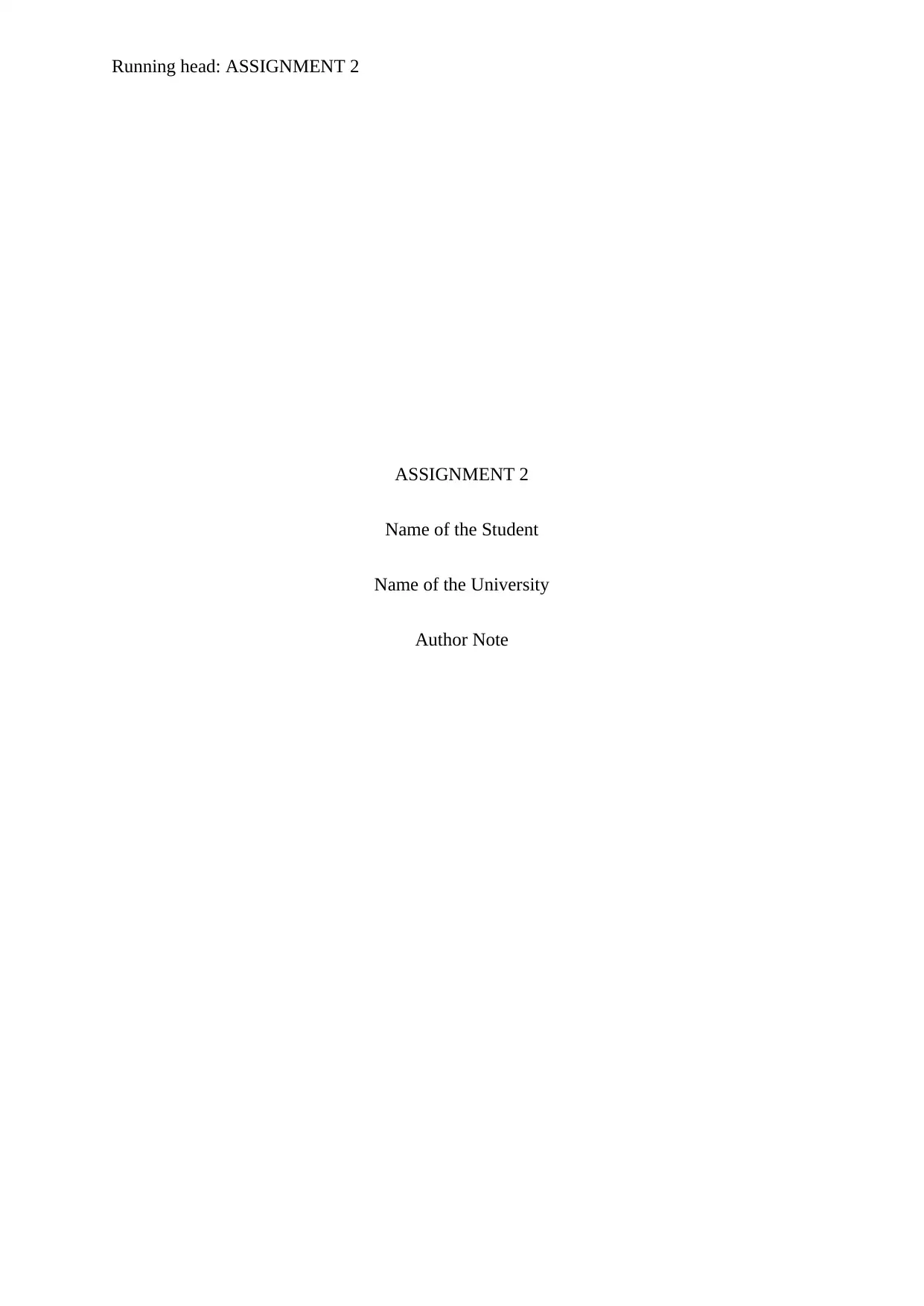
Running head: ASSIGNMENT 2
ASSIGNMENT 2
Name of the Student
Name of the University
Author Note
ASSIGNMENT 2
Name of the Student
Name of the University
Author Note
Paraphrase This Document
Need a fresh take? Get an instant paraphrase of this document with our AI Paraphraser
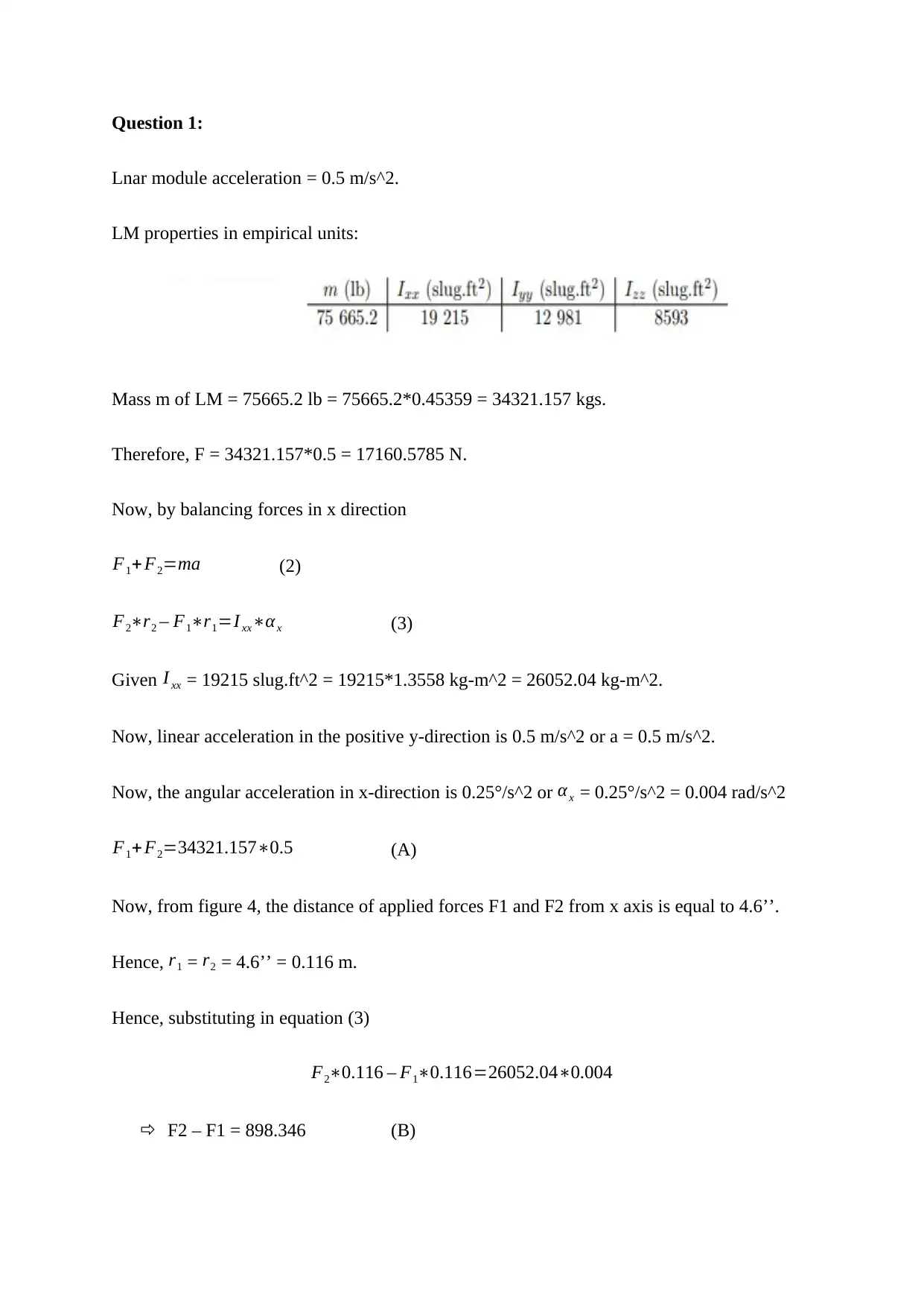
Question 1:
Lnar module acceleration = 0.5 m/s^2.
LM properties in empirical units:
Mass m of LM = 75665.2 lb = 75665.2*0.45359 = 34321.157 kgs.
Therefore, F = 34321.157*0.5 = 17160.5785 N.
Now, by balancing forces in x direction
F1+F2=ma (2)
F2∗r2 – F1∗r1=I xx∗αx (3)
Given I xx = 19215 slug.ft^2 = 19215*1.3558 kg-m^2 = 26052.04 kg-m^2.
Now, linear acceleration in the positive y-direction is 0.5 m/s^2 or a = 0.5 m/s^2.
Now, the angular acceleration in x-direction is 0.25°/s^2 or αx = 0.25°/s^2 = 0.004 rad/s^2
F1+F2=34321.157∗0.5 (A)
Now, from figure 4, the distance of applied forces F1 and F2 from x axis is equal to 4.6’’.
Hence, r1 = r2 = 4.6’’ = 0.116 m.
Hence, substituting in equation (3)
F2∗0.116 – F1∗0.116=26052.04∗0.004
F2 – F1 = 898.346 (B)
Lnar module acceleration = 0.5 m/s^2.
LM properties in empirical units:
Mass m of LM = 75665.2 lb = 75665.2*0.45359 = 34321.157 kgs.
Therefore, F = 34321.157*0.5 = 17160.5785 N.
Now, by balancing forces in x direction
F1+F2=ma (2)
F2∗r2 – F1∗r1=I xx∗αx (3)
Given I xx = 19215 slug.ft^2 = 19215*1.3558 kg-m^2 = 26052.04 kg-m^2.
Now, linear acceleration in the positive y-direction is 0.5 m/s^2 or a = 0.5 m/s^2.
Now, the angular acceleration in x-direction is 0.25°/s^2 or αx = 0.25°/s^2 = 0.004 rad/s^2
F1+F2=34321.157∗0.5 (A)
Now, from figure 4, the distance of applied forces F1 and F2 from x axis is equal to 4.6’’.
Hence, r1 = r2 = 4.6’’ = 0.116 m.
Hence, substituting in equation (3)
F2∗0.116 – F1∗0.116=26052.04∗0.004
F2 – F1 = 898.346 (B)

Now, solving (A) and (B) gives
F1 = 8131.1 N.
F2 = 9029.5 N.
Now, (2) and (3) in matrix form is given by,
[ 1 1
−r 1 r 2 ][ F 1
F 2 ] =
[ ma
I xx∗αx ]
Putting values,
[ 1 1
−0.116 0.116 ][ F 1
F 2 ] = [ 34321.157∗0.5
26052.04∗0.004 ]
Hence, [ F 1
F 2 ] = [ 1 1
−0.116 0.116 ]−1
[ 34321.157∗0.5
26052.04∗0.004 ]
[ F 1
F 2 ] = [ 8131.1
9029.5 ]
The above results are verified by MATLAB as given below.
MATLAB code:
a = 0.5; % acceleration in m/s^2
m = 75665.2*0.45359; % mass of LM
format shortG
F = m*a
r1 = 0.116; r2 = r1; % the distance of applied forces F1 and F2 from x axis
Ixx = 19215*1.3558; % moment of inertia about x axis in kg-m^2
F1 = 8131.1 N.
F2 = 9029.5 N.
Now, (2) and (3) in matrix form is given by,
[ 1 1
−r 1 r 2 ][ F 1
F 2 ] =
[ ma
I xx∗αx ]
Putting values,
[ 1 1
−0.116 0.116 ][ F 1
F 2 ] = [ 34321.157∗0.5
26052.04∗0.004 ]
Hence, [ F 1
F 2 ] = [ 1 1
−0.116 0.116 ]−1
[ 34321.157∗0.5
26052.04∗0.004 ]
[ F 1
F 2 ] = [ 8131.1
9029.5 ]
The above results are verified by MATLAB as given below.
MATLAB code:
a = 0.5; % acceleration in m/s^2
m = 75665.2*0.45359; % mass of LM
format shortG
F = m*a
r1 = 0.116; r2 = r1; % the distance of applied forces F1 and F2 from x axis
Ixx = 19215*1.3558; % moment of inertia about x axis in kg-m^2
⊘ This is a preview!⊘
Do you want full access?
Subscribe today to unlock all pages.

Trusted by 1+ million students worldwide
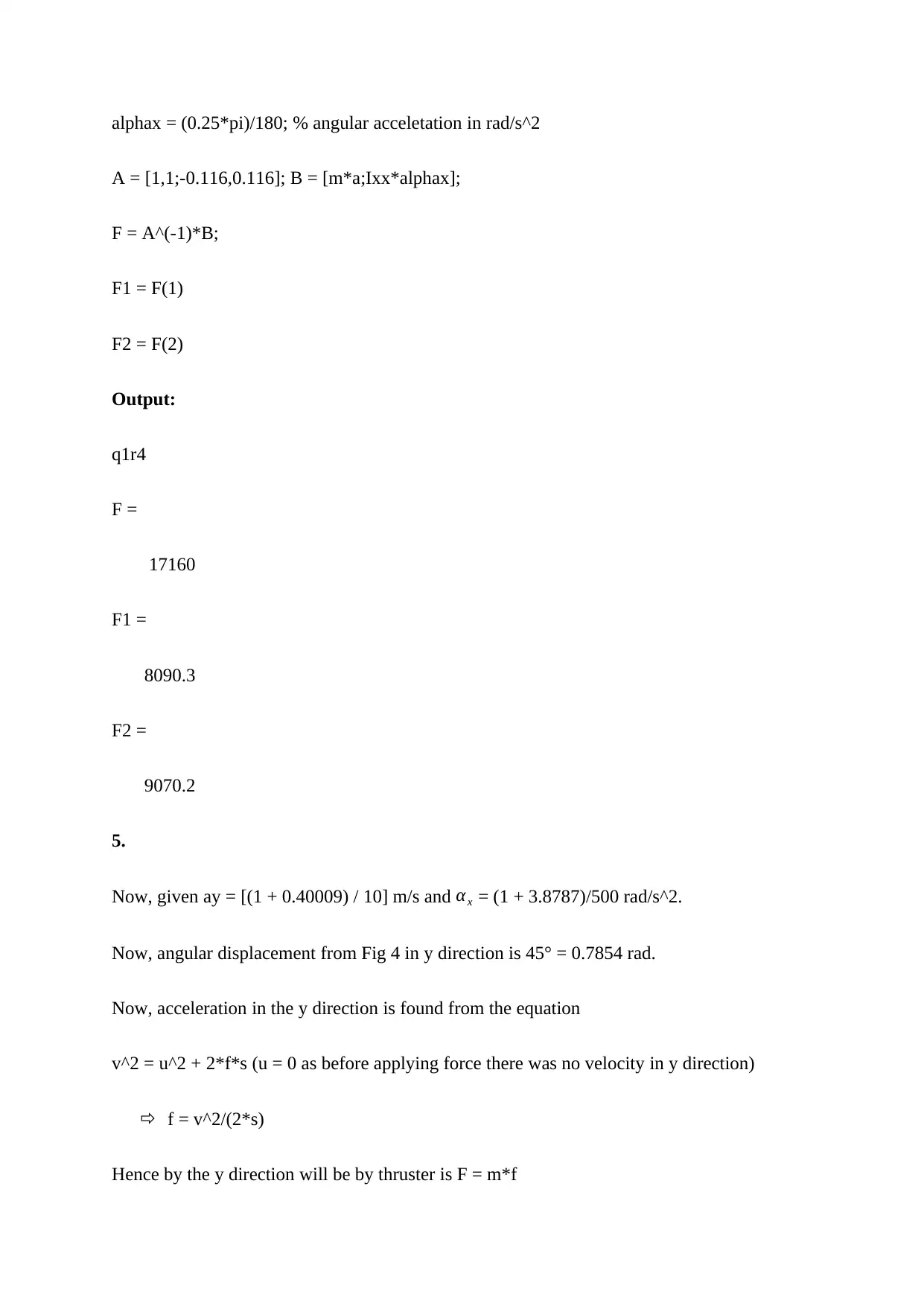
alphax = (0.25*pi)/180; % angular acceletation in rad/s^2
A = [1,1;-0.116,0.116]; B = [m*a;Ixx*alphax];
F = A^(-1)*B;
F1 = F(1)
F2 = F(2)
Output:
q1r4
F =
17160
F1 =
8090.3
F2 =
9070.2
5.
Now, given ay = [(1 + 0.40009) / 10] m/s and α x = (1 + 3.8787)/500 rad/s^2.
Now, angular displacement from Fig 4 in y direction is 45° = 0.7854 rad.
Now, acceleration in the y direction is found from the equation
v^2 = u^2 + 2*f*s (u = 0 as before applying force there was no velocity in y direction)
f = v^2/(2*s)
Hence by the y direction will be by thruster is F = m*f
A = [1,1;-0.116,0.116]; B = [m*a;Ixx*alphax];
F = A^(-1)*B;
F1 = F(1)
F2 = F(2)
Output:
q1r4
F =
17160
F1 =
8090.3
F2 =
9070.2
5.
Now, given ay = [(1 + 0.40009) / 10] m/s and α x = (1 + 3.8787)/500 rad/s^2.
Now, angular displacement from Fig 4 in y direction is 45° = 0.7854 rad.
Now, acceleration in the y direction is found from the equation
v^2 = u^2 + 2*f*s (u = 0 as before applying force there was no velocity in y direction)
f = v^2/(2*s)
Hence by the y direction will be by thruster is F = m*f
Paraphrase This Document
Need a fresh take? Get an instant paraphrase of this document with our AI Paraphraser
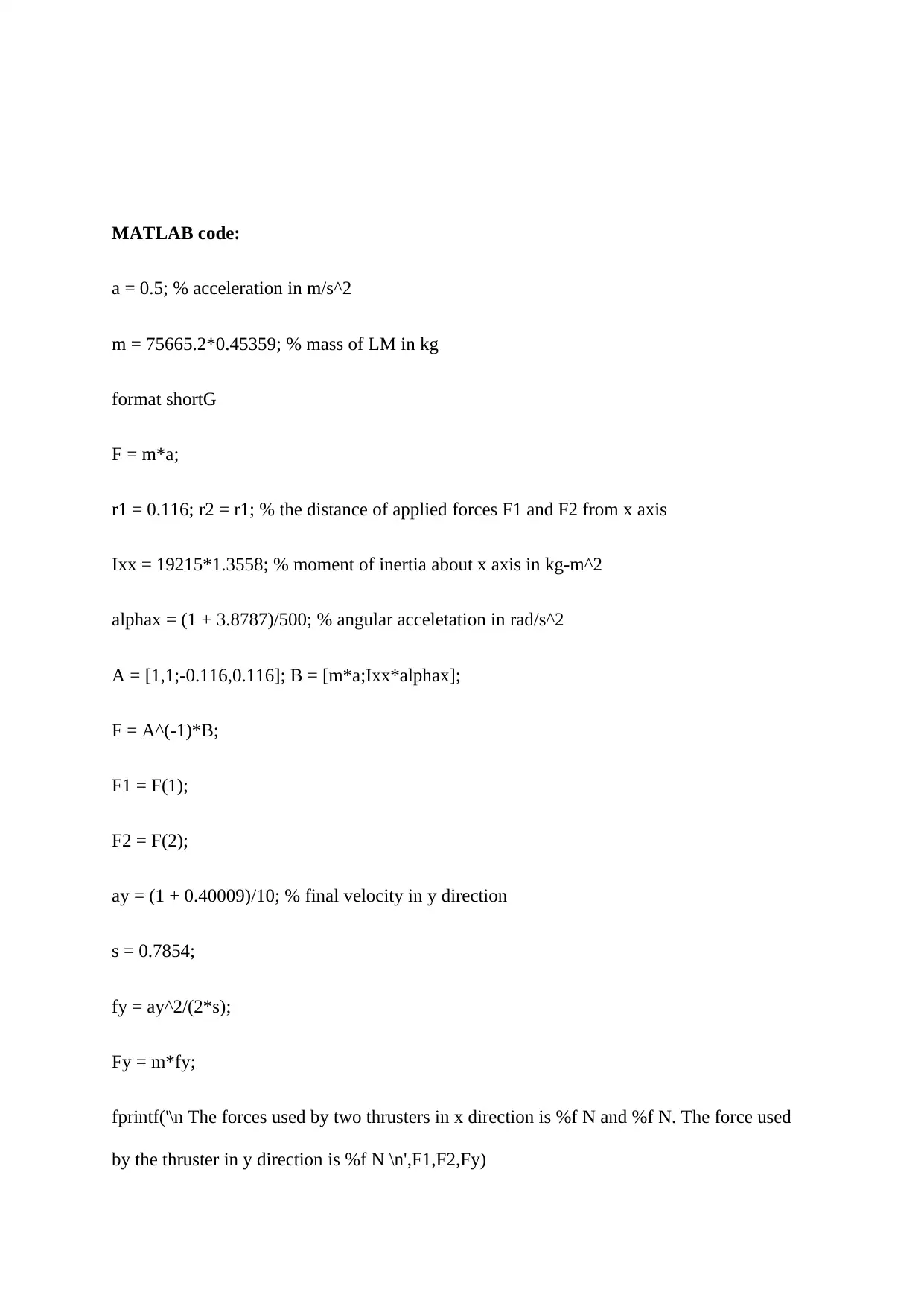
MATLAB code:
a = 0.5; % acceleration in m/s^2
m = 75665.2*0.45359; % mass of LM in kg
format shortG
F = m*a;
r1 = 0.116; r2 = r1; % the distance of applied forces F1 and F2 from x axis
Ixx = 19215*1.3558; % moment of inertia about x axis in kg-m^2
alphax = (1 + 3.8787)/500; % angular acceletation in rad/s^2
A = [1,1;-0.116,0.116]; B = [m*a;Ixx*alphax];
F = A^(-1)*B;
F1 = F(1);
F2 = F(2);
ay = (1 + 0.40009)/10; % final velocity in y direction
s = 0.7854;
fy = ay^2/(2*s);
Fy = m*fy;
fprintf('\n The forces used by two thrusters in x direction is %f N and %f N. The force used
by the thruster in y direction is %f N \n',F1,F2,Fy)
a = 0.5; % acceleration in m/s^2
m = 75665.2*0.45359; % mass of LM in kg
format shortG
F = m*a;
r1 = 0.116; r2 = r1; % the distance of applied forces F1 and F2 from x axis
Ixx = 19215*1.3558; % moment of inertia about x axis in kg-m^2
alphax = (1 + 3.8787)/500; % angular acceletation in rad/s^2
A = [1,1;-0.116,0.116]; B = [m*a;Ixx*alphax];
F = A^(-1)*B;
F1 = F(1);
F2 = F(2);
ay = (1 + 0.40009)/10; % final velocity in y direction
s = 0.7854;
fy = ay^2/(2*s);
Fy = m*fy;
fprintf('\n The forces used by two thrusters in x direction is %f N and %f N. The force used
by the thruster in y direction is %f N \n',F1,F2,Fy)
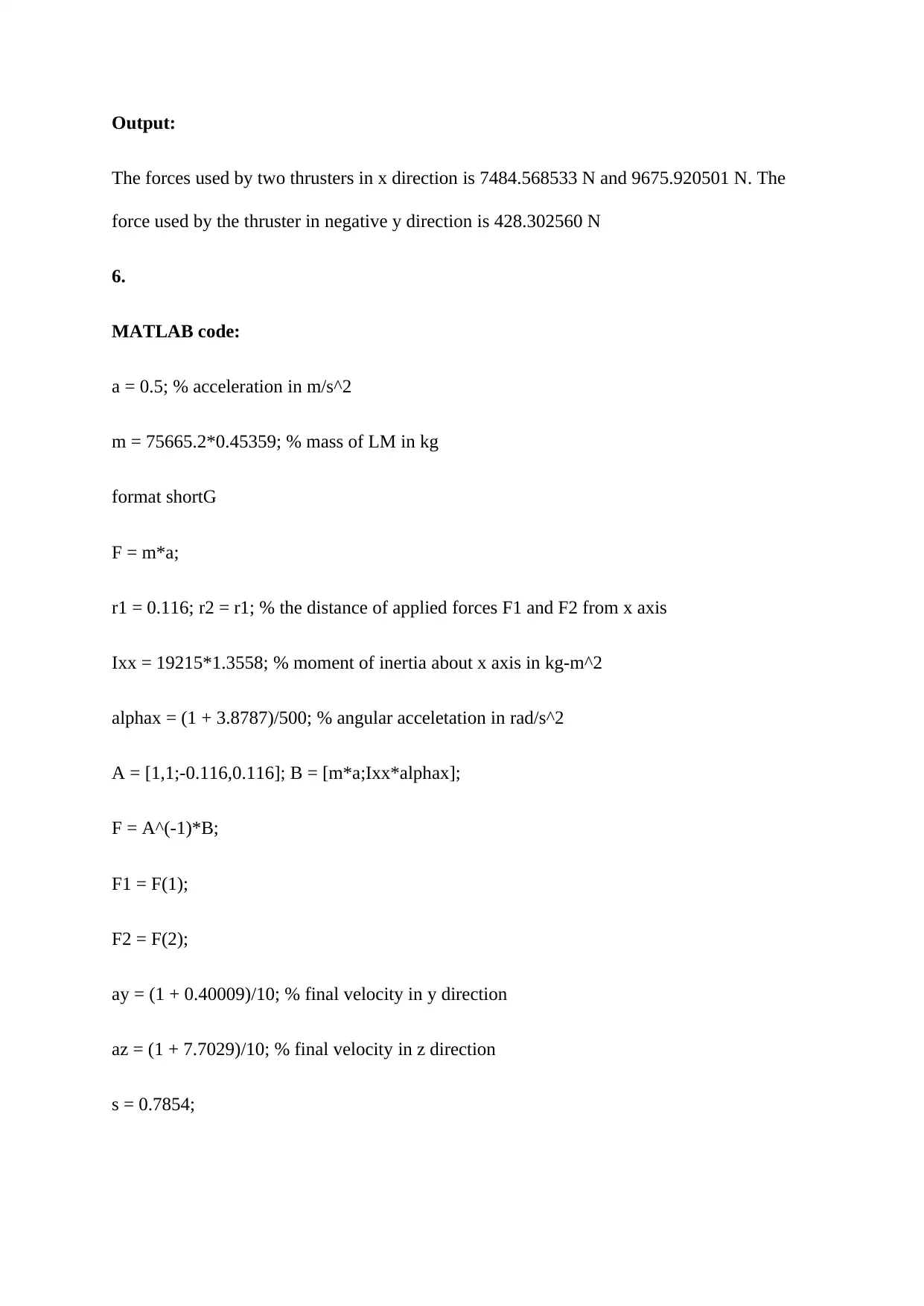
Output:
The forces used by two thrusters in x direction is 7484.568533 N and 9675.920501 N. The
force used by the thruster in negative y direction is 428.302560 N
6.
MATLAB code:
a = 0.5; % acceleration in m/s^2
m = 75665.2*0.45359; % mass of LM in kg
format shortG
F = m*a;
r1 = 0.116; r2 = r1; % the distance of applied forces F1 and F2 from x axis
Ixx = 19215*1.3558; % moment of inertia about x axis in kg-m^2
alphax = (1 + 3.8787)/500; % angular acceletation in rad/s^2
A = [1,1;-0.116,0.116]; B = [m*a;Ixx*alphax];
F = A^(-1)*B;
F1 = F(1);
F2 = F(2);
ay = (1 + 0.40009)/10; % final velocity in y direction
az = (1 + 7.7029)/10; % final velocity in z direction
s = 0.7854;
The forces used by two thrusters in x direction is 7484.568533 N and 9675.920501 N. The
force used by the thruster in negative y direction is 428.302560 N
6.
MATLAB code:
a = 0.5; % acceleration in m/s^2
m = 75665.2*0.45359; % mass of LM in kg
format shortG
F = m*a;
r1 = 0.116; r2 = r1; % the distance of applied forces F1 and F2 from x axis
Ixx = 19215*1.3558; % moment of inertia about x axis in kg-m^2
alphax = (1 + 3.8787)/500; % angular acceletation in rad/s^2
A = [1,1;-0.116,0.116]; B = [m*a;Ixx*alphax];
F = A^(-1)*B;
F1 = F(1);
F2 = F(2);
ay = (1 + 0.40009)/10; % final velocity in y direction
az = (1 + 7.7029)/10; % final velocity in z direction
s = 0.7854;
⊘ This is a preview!⊘
Do you want full access?
Subscribe today to unlock all pages.

Trusted by 1+ million students worldwide

fy = ay^2/(2*s); % linear acceleration in y direction
fz = az^2/(2*s); % linear accleartion in z direction
Fy = m*fy; % force in y direction
Fz = m*fz; % force in z direction
fprintf('\n Cluster 2: The forces used by two thrusters in x direction is %f N and %f N.\n The
force used by the thruster in negative y direction is %f and by the thruster in the negative z
direction is %f N\n',F1,F2,Fy,Fz)
Output:
Cluster 2: The forces used by two thrusters in x direction is 7484.568533 N and 9675.920501
N.
The force used by the thruster in negative y direction is 428.302560 and by the thruster in the
negative z direction is 16548.809238 N
7.
Now, the velocities and acceleration in all the direction is considered. Hence, the matrix
equation becomes
[ 1 1
−r 1 r 2 ][ F 1
F 2 ] =
[ ma
Ixx∗α x+ I yy∗α y + Izz∗αz ]
Hence, [ F 1
F 2 ] = [ 1 1
−r 1 r 2 ]−1
[ ma
Ixx∗α x+I yy∗α y + I zz∗αz ]
MATLAB code:
a = 0.5; % acceleration in m/s^2
fz = az^2/(2*s); % linear accleartion in z direction
Fy = m*fy; % force in y direction
Fz = m*fz; % force in z direction
fprintf('\n Cluster 2: The forces used by two thrusters in x direction is %f N and %f N.\n The
force used by the thruster in negative y direction is %f and by the thruster in the negative z
direction is %f N\n',F1,F2,Fy,Fz)
Output:
Cluster 2: The forces used by two thrusters in x direction is 7484.568533 N and 9675.920501
N.
The force used by the thruster in negative y direction is 428.302560 and by the thruster in the
negative z direction is 16548.809238 N
7.
Now, the velocities and acceleration in all the direction is considered. Hence, the matrix
equation becomes
[ 1 1
−r 1 r 2 ][ F 1
F 2 ] =
[ ma
Ixx∗α x+ I yy∗α y + Izz∗αz ]
Hence, [ F 1
F 2 ] = [ 1 1
−r 1 r 2 ]−1
[ ma
Ixx∗α x+I yy∗α y + I zz∗αz ]
MATLAB code:
a = 0.5; % acceleration in m/s^2
Paraphrase This Document
Need a fresh take? Get an instant paraphrase of this document with our AI Paraphraser
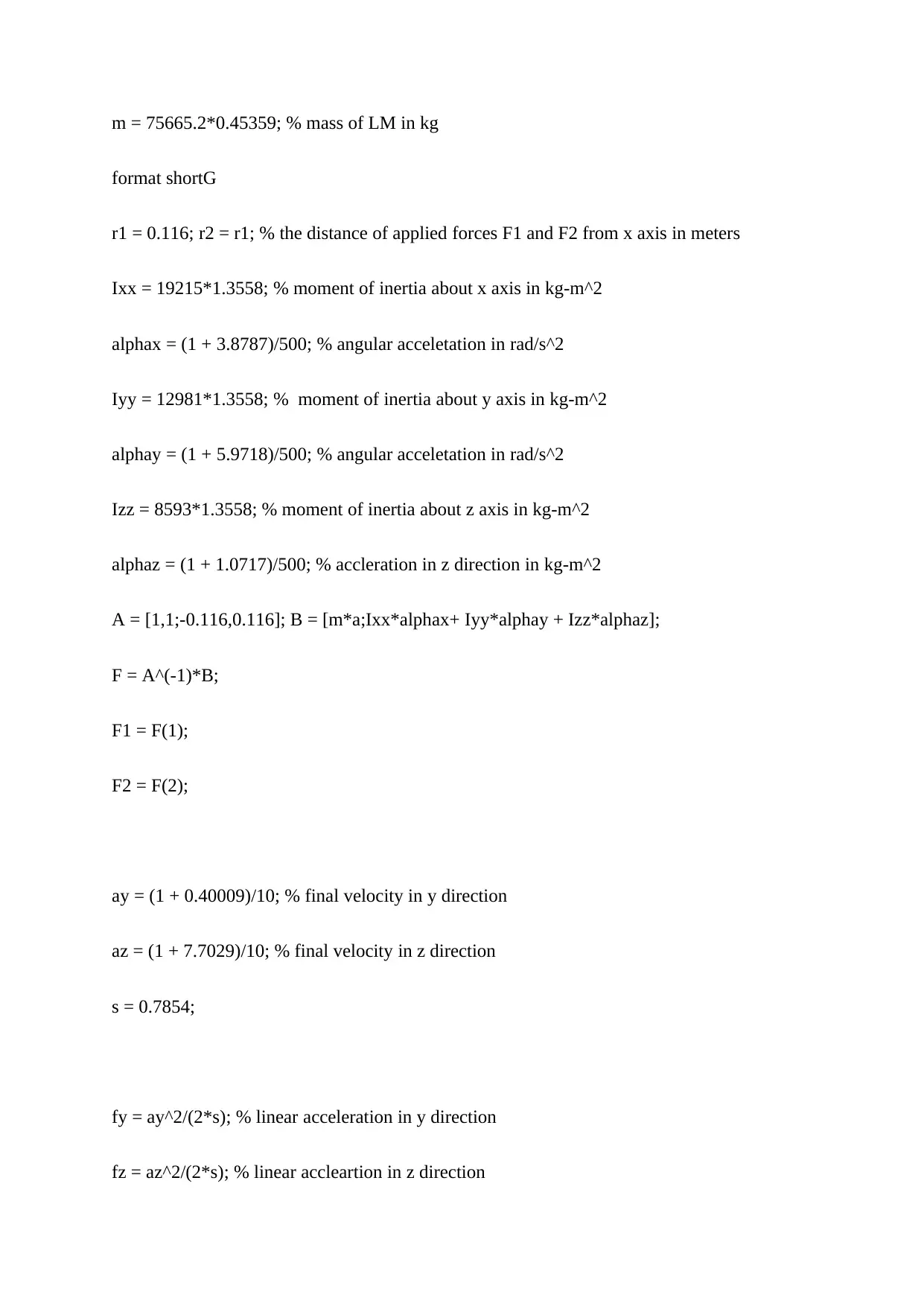
m = 75665.2*0.45359; % mass of LM in kg
format shortG
r1 = 0.116; r2 = r1; % the distance of applied forces F1 and F2 from x axis in meters
Ixx = 19215*1.3558; % moment of inertia about x axis in kg-m^2
alphax = (1 + 3.8787)/500; % angular acceletation in rad/s^2
Iyy = 12981*1.3558; % moment of inertia about y axis in kg-m^2
alphay = (1 + 5.9718)/500; % angular acceletation in rad/s^2
Izz = 8593*1.3558; % moment of inertia about z axis in kg-m^2
alphaz = (1 + 1.0717)/500; % accleration in z direction in kg-m^2
A = [1,1;-0.116,0.116]; B = [m*a;Ixx*alphax+ Iyy*alphay + Izz*alphaz];
F = A^(-1)*B;
F1 = F(1);
F2 = F(2);
ay = (1 + 0.40009)/10; % final velocity in y direction
az = (1 + 7.7029)/10; % final velocity in z direction
s = 0.7854;
fy = ay^2/(2*s); % linear acceleration in y direction
fz = az^2/(2*s); % linear accleartion in z direction
format shortG
r1 = 0.116; r2 = r1; % the distance of applied forces F1 and F2 from x axis in meters
Ixx = 19215*1.3558; % moment of inertia about x axis in kg-m^2
alphax = (1 + 3.8787)/500; % angular acceletation in rad/s^2
Iyy = 12981*1.3558; % moment of inertia about y axis in kg-m^2
alphay = (1 + 5.9718)/500; % angular acceletation in rad/s^2
Izz = 8593*1.3558; % moment of inertia about z axis in kg-m^2
alphaz = (1 + 1.0717)/500; % accleration in z direction in kg-m^2
A = [1,1;-0.116,0.116]; B = [m*a;Ixx*alphax+ Iyy*alphay + Izz*alphaz];
F = A^(-1)*B;
F1 = F(1);
F2 = F(2);
ay = (1 + 0.40009)/10; % final velocity in y direction
az = (1 + 7.7029)/10; % final velocity in z direction
s = 0.7854;
fy = ay^2/(2*s); % linear acceleration in y direction
fz = az^2/(2*s); % linear accleartion in z direction

Fy = m*fy; % force in y direction
Fz = m*fz; % force in z direction
fprintf('\n Cluster 1: The forces used by two thrusters in x direction is %f N and %f N.\n The
force used by the thruster in negative y direction is %f and by the thruster in the positive z
direction is %f N\n',F1,F2,Fy,Fz)
fprintf('\n Cluster 2: The forces used by two thrusters in x direction is %f N and %f N.\n The
force used by the thruster in negative y direction is %f and by the thruster in the negative z
direction is %f N\n',F1,F2,Fy,Fz)
fprintf('\n Cluster 3: The forces used by two thrusters in x direction is %f N and %f N.\n The
force used by the thruster in positive y direction is %f and by the thruster in the negative z
direction is %f N\n',F1,F2,Fy,Fz)
fprintf('\n Cluster 4: The forces used by two thrusters in x direction is %f N and %f N.\n The
force used by the thruster in positive y direction is %f and by the thruster in the positive z
direction is %f N\n',F1,F2,Fy,Fz)
Output:
Cluster 1: The forces used by two thrusters in x direction is 6218.729908 N and
10941.759126 N.
The force used by the thruster in negative y direction is 428.302560 and by the thruster in the
positive z direction is 16548.809238 N
Fz = m*fz; % force in z direction
fprintf('\n Cluster 1: The forces used by two thrusters in x direction is %f N and %f N.\n The
force used by the thruster in negative y direction is %f and by the thruster in the positive z
direction is %f N\n',F1,F2,Fy,Fz)
fprintf('\n Cluster 2: The forces used by two thrusters in x direction is %f N and %f N.\n The
force used by the thruster in negative y direction is %f and by the thruster in the negative z
direction is %f N\n',F1,F2,Fy,Fz)
fprintf('\n Cluster 3: The forces used by two thrusters in x direction is %f N and %f N.\n The
force used by the thruster in positive y direction is %f and by the thruster in the negative z
direction is %f N\n',F1,F2,Fy,Fz)
fprintf('\n Cluster 4: The forces used by two thrusters in x direction is %f N and %f N.\n The
force used by the thruster in positive y direction is %f and by the thruster in the positive z
direction is %f N\n',F1,F2,Fy,Fz)
Output:
Cluster 1: The forces used by two thrusters in x direction is 6218.729908 N and
10941.759126 N.
The force used by the thruster in negative y direction is 428.302560 and by the thruster in the
positive z direction is 16548.809238 N
⊘ This is a preview!⊘
Do you want full access?
Subscribe today to unlock all pages.

Trusted by 1+ million students worldwide
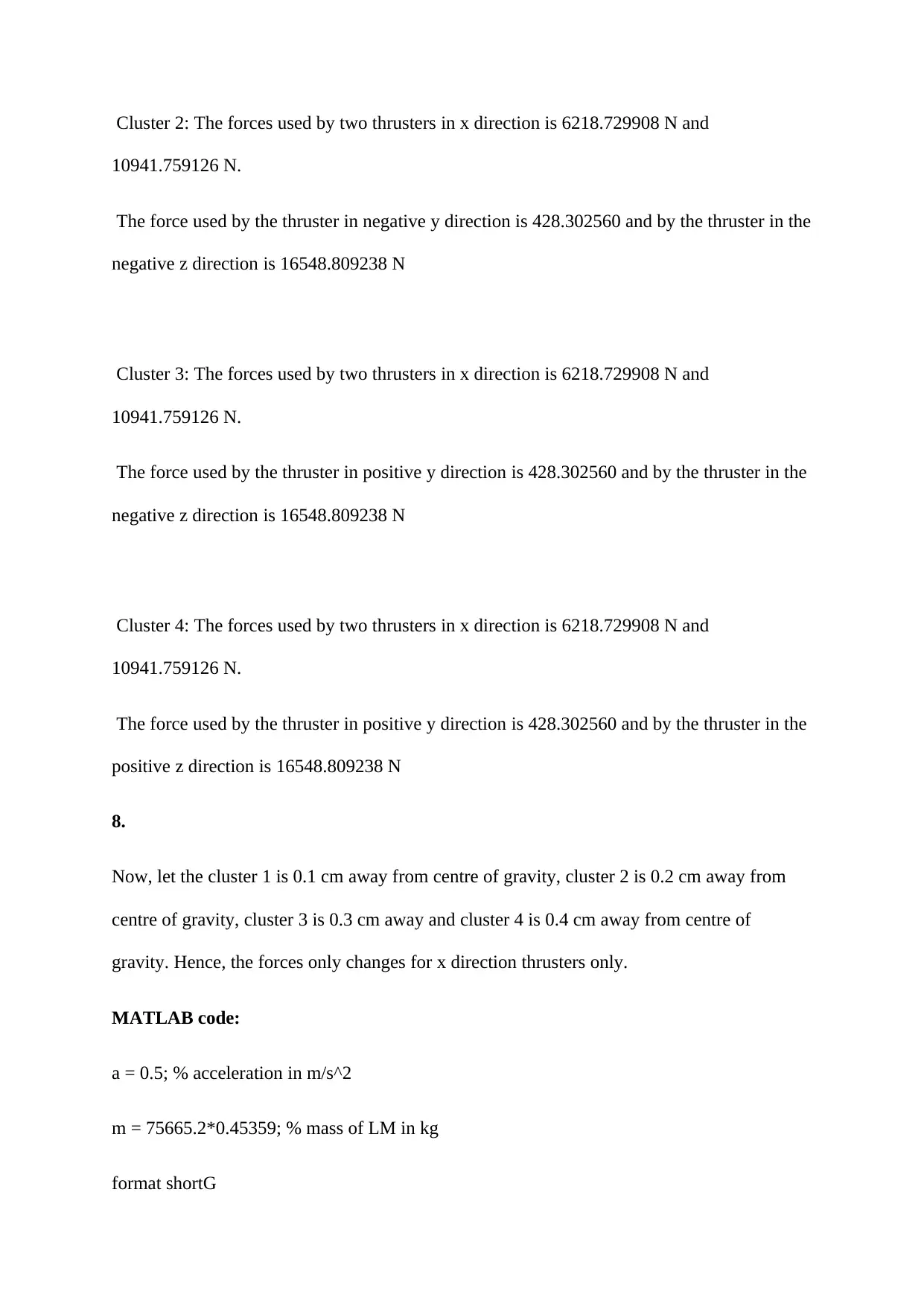
Cluster 2: The forces used by two thrusters in x direction is 6218.729908 N and
10941.759126 N.
The force used by the thruster in negative y direction is 428.302560 and by the thruster in the
negative z direction is 16548.809238 N
Cluster 3: The forces used by two thrusters in x direction is 6218.729908 N and
10941.759126 N.
The force used by the thruster in positive y direction is 428.302560 and by the thruster in the
negative z direction is 16548.809238 N
Cluster 4: The forces used by two thrusters in x direction is 6218.729908 N and
10941.759126 N.
The force used by the thruster in positive y direction is 428.302560 and by the thruster in the
positive z direction is 16548.809238 N
8.
Now, let the cluster 1 is 0.1 cm away from centre of gravity, cluster 2 is 0.2 cm away from
centre of gravity, cluster 3 is 0.3 cm away and cluster 4 is 0.4 cm away from centre of
gravity. Hence, the forces only changes for x direction thrusters only.
MATLAB code:
a = 0.5; % acceleration in m/s^2
m = 75665.2*0.45359; % mass of LM in kg
format shortG
10941.759126 N.
The force used by the thruster in negative y direction is 428.302560 and by the thruster in the
negative z direction is 16548.809238 N
Cluster 3: The forces used by two thrusters in x direction is 6218.729908 N and
10941.759126 N.
The force used by the thruster in positive y direction is 428.302560 and by the thruster in the
negative z direction is 16548.809238 N
Cluster 4: The forces used by two thrusters in x direction is 6218.729908 N and
10941.759126 N.
The force used by the thruster in positive y direction is 428.302560 and by the thruster in the
positive z direction is 16548.809238 N
8.
Now, let the cluster 1 is 0.1 cm away from centre of gravity, cluster 2 is 0.2 cm away from
centre of gravity, cluster 3 is 0.3 cm away and cluster 4 is 0.4 cm away from centre of
gravity. Hence, the forces only changes for x direction thrusters only.
MATLAB code:
a = 0.5; % acceleration in m/s^2
m = 75665.2*0.45359; % mass of LM in kg
format shortG
Paraphrase This Document
Need a fresh take? Get an instant paraphrase of this document with our AI Paraphraser
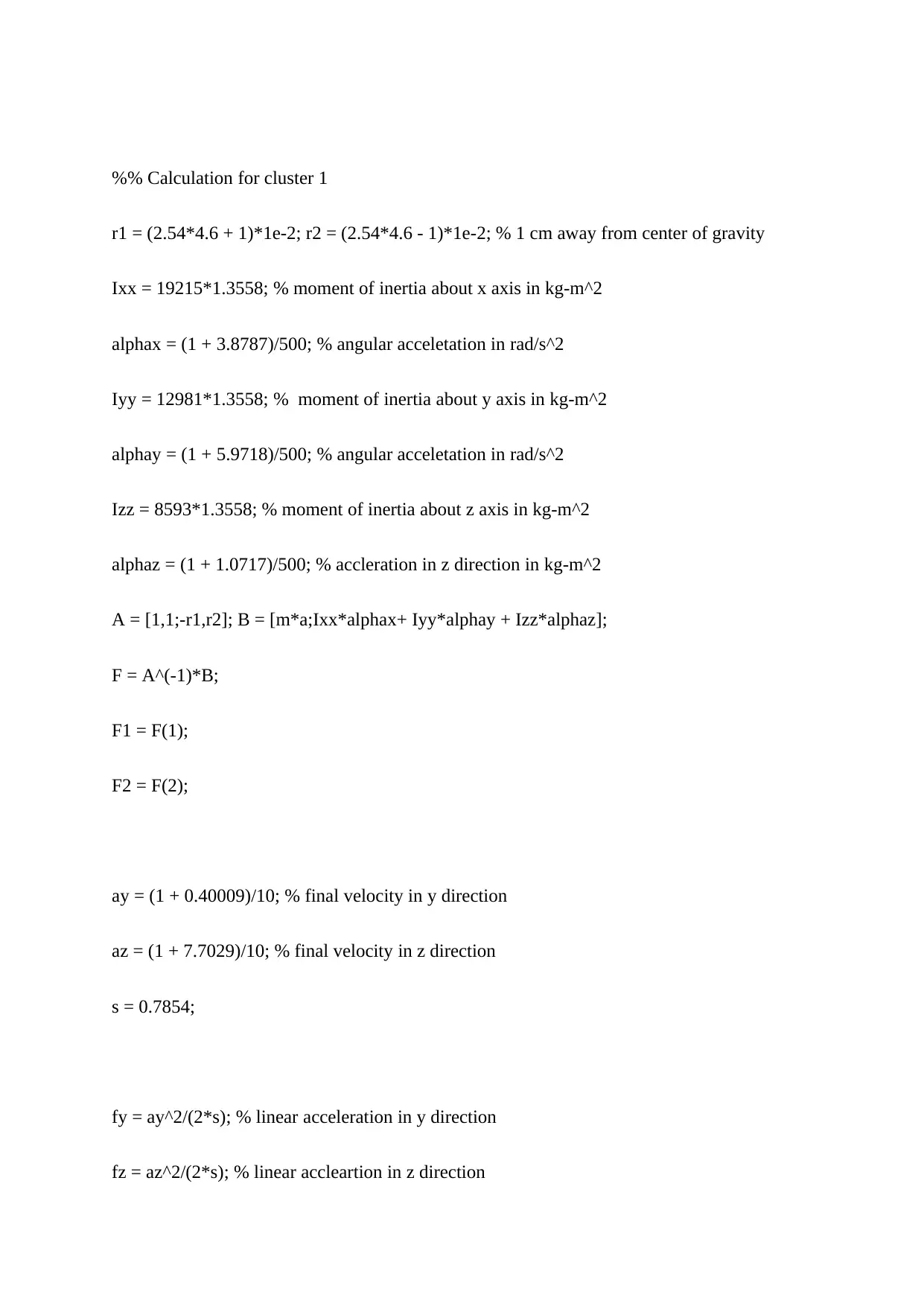
%% Calculation for cluster 1
r1 = (2.54*4.6 + 1)*1e-2; r2 = (2.54*4.6 - 1)*1e-2; % 1 cm away from center of gravity
Ixx = 19215*1.3558; % moment of inertia about x axis in kg-m^2
alphax = (1 + 3.8787)/500; % angular acceletation in rad/s^2
Iyy = 12981*1.3558; % moment of inertia about y axis in kg-m^2
alphay = (1 + 5.9718)/500; % angular acceletation in rad/s^2
Izz = 8593*1.3558; % moment of inertia about z axis in kg-m^2
alphaz = (1 + 1.0717)/500; % accleration in z direction in kg-m^2
A = [1,1;-r1,r2]; B = [m*a;Ixx*alphax+ Iyy*alphay + Izz*alphaz];
F = A^(-1)*B;
F1 = F(1);
F2 = F(2);
ay = (1 + 0.40009)/10; % final velocity in y direction
az = (1 + 7.7029)/10; % final velocity in z direction
s = 0.7854;
fy = ay^2/(2*s); % linear acceleration in y direction
fz = az^2/(2*s); % linear accleartion in z direction
r1 = (2.54*4.6 + 1)*1e-2; r2 = (2.54*4.6 - 1)*1e-2; % 1 cm away from center of gravity
Ixx = 19215*1.3558; % moment of inertia about x axis in kg-m^2
alphax = (1 + 3.8787)/500; % angular acceletation in rad/s^2
Iyy = 12981*1.3558; % moment of inertia about y axis in kg-m^2
alphay = (1 + 5.9718)/500; % angular acceletation in rad/s^2
Izz = 8593*1.3558; % moment of inertia about z axis in kg-m^2
alphaz = (1 + 1.0717)/500; % accleration in z direction in kg-m^2
A = [1,1;-r1,r2]; B = [m*a;Ixx*alphax+ Iyy*alphay + Izz*alphaz];
F = A^(-1)*B;
F1 = F(1);
F2 = F(2);
ay = (1 + 0.40009)/10; % final velocity in y direction
az = (1 + 7.7029)/10; % final velocity in z direction
s = 0.7854;
fy = ay^2/(2*s); % linear acceleration in y direction
fz = az^2/(2*s); % linear accleartion in z direction
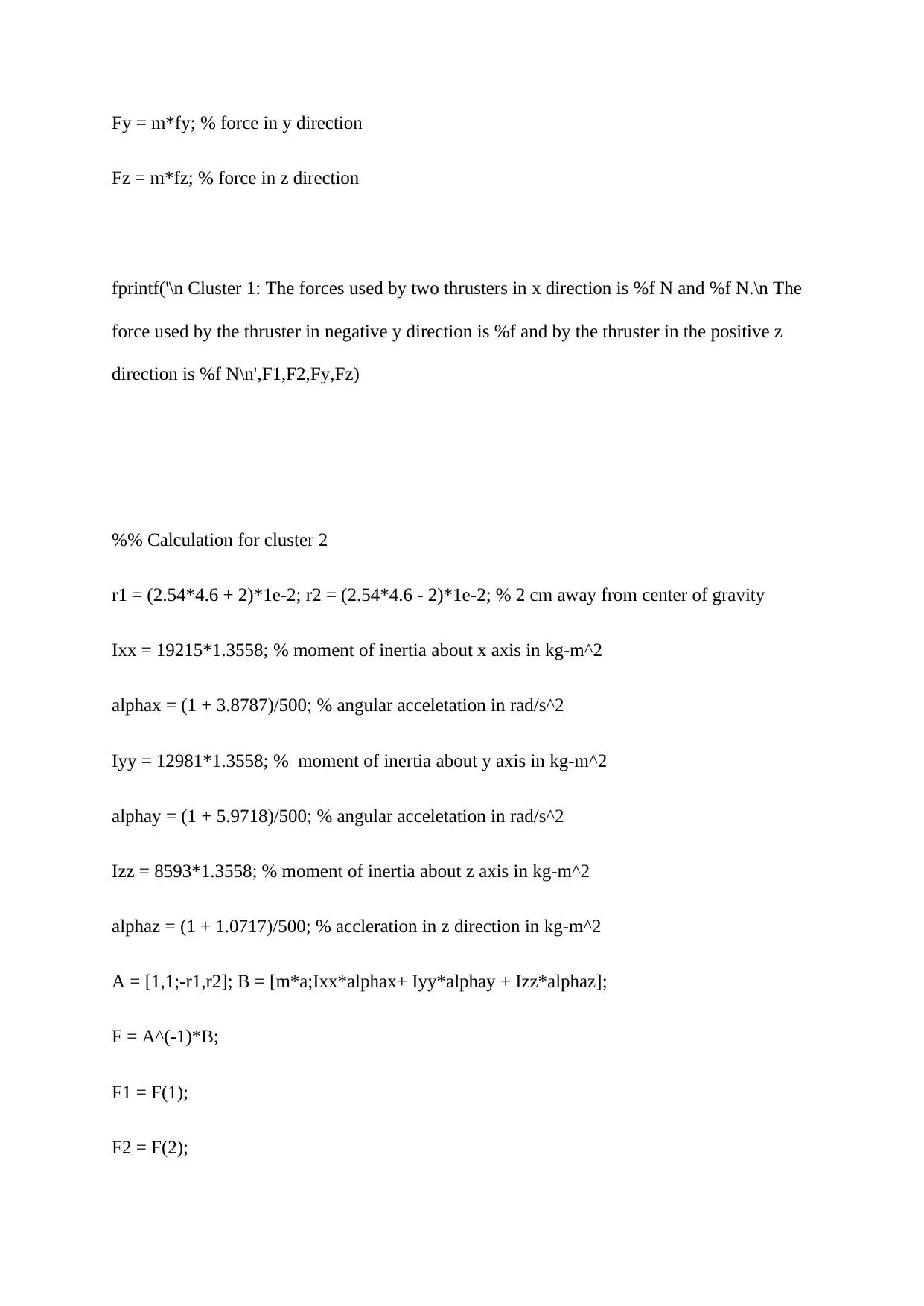
Fy = m*fy; % force in y direction
Fz = m*fz; % force in z direction
fprintf('\n Cluster 1: The forces used by two thrusters in x direction is %f N and %f N.\n The
force used by the thruster in negative y direction is %f and by the thruster in the positive z
direction is %f N\n',F1,F2,Fy,Fz)
%% Calculation for cluster 2
r1 = (2.54*4.6 + 2)*1e-2; r2 = (2.54*4.6 - 2)*1e-2; % 2 cm away from center of gravity
Ixx = 19215*1.3558; % moment of inertia about x axis in kg-m^2
alphax = (1 + 3.8787)/500; % angular acceletation in rad/s^2
Iyy = 12981*1.3558; % moment of inertia about y axis in kg-m^2
alphay = (1 + 5.9718)/500; % angular acceletation in rad/s^2
Izz = 8593*1.3558; % moment of inertia about z axis in kg-m^2
alphaz = (1 + 1.0717)/500; % accleration in z direction in kg-m^2
A = [1,1;-r1,r2]; B = [m*a;Ixx*alphax+ Iyy*alphay + Izz*alphaz];
F = A^(-1)*B;
F1 = F(1);
F2 = F(2);
Fz = m*fz; % force in z direction
fprintf('\n Cluster 1: The forces used by two thrusters in x direction is %f N and %f N.\n The
force used by the thruster in negative y direction is %f and by the thruster in the positive z
direction is %f N\n',F1,F2,Fy,Fz)
%% Calculation for cluster 2
r1 = (2.54*4.6 + 2)*1e-2; r2 = (2.54*4.6 - 2)*1e-2; % 2 cm away from center of gravity
Ixx = 19215*1.3558; % moment of inertia about x axis in kg-m^2
alphax = (1 + 3.8787)/500; % angular acceletation in rad/s^2
Iyy = 12981*1.3558; % moment of inertia about y axis in kg-m^2
alphay = (1 + 5.9718)/500; % angular acceletation in rad/s^2
Izz = 8593*1.3558; % moment of inertia about z axis in kg-m^2
alphaz = (1 + 1.0717)/500; % accleration in z direction in kg-m^2
A = [1,1;-r1,r2]; B = [m*a;Ixx*alphax+ Iyy*alphay + Izz*alphaz];
F = A^(-1)*B;
F1 = F(1);
F2 = F(2);
⊘ This is a preview!⊘
Do you want full access?
Subscribe today to unlock all pages.

Trusted by 1+ million students worldwide
1 out of 28
Related Documents
Your All-in-One AI-Powered Toolkit for Academic Success.
+13062052269
info@desklib.com
Available 24*7 on WhatsApp / Email
![[object Object]](/_next/static/media/star-bottom.7253800d.svg)
Unlock your academic potential
Copyright © 2020–2025 A2Z Services. All Rights Reserved. Developed and managed by ZUCOL.




